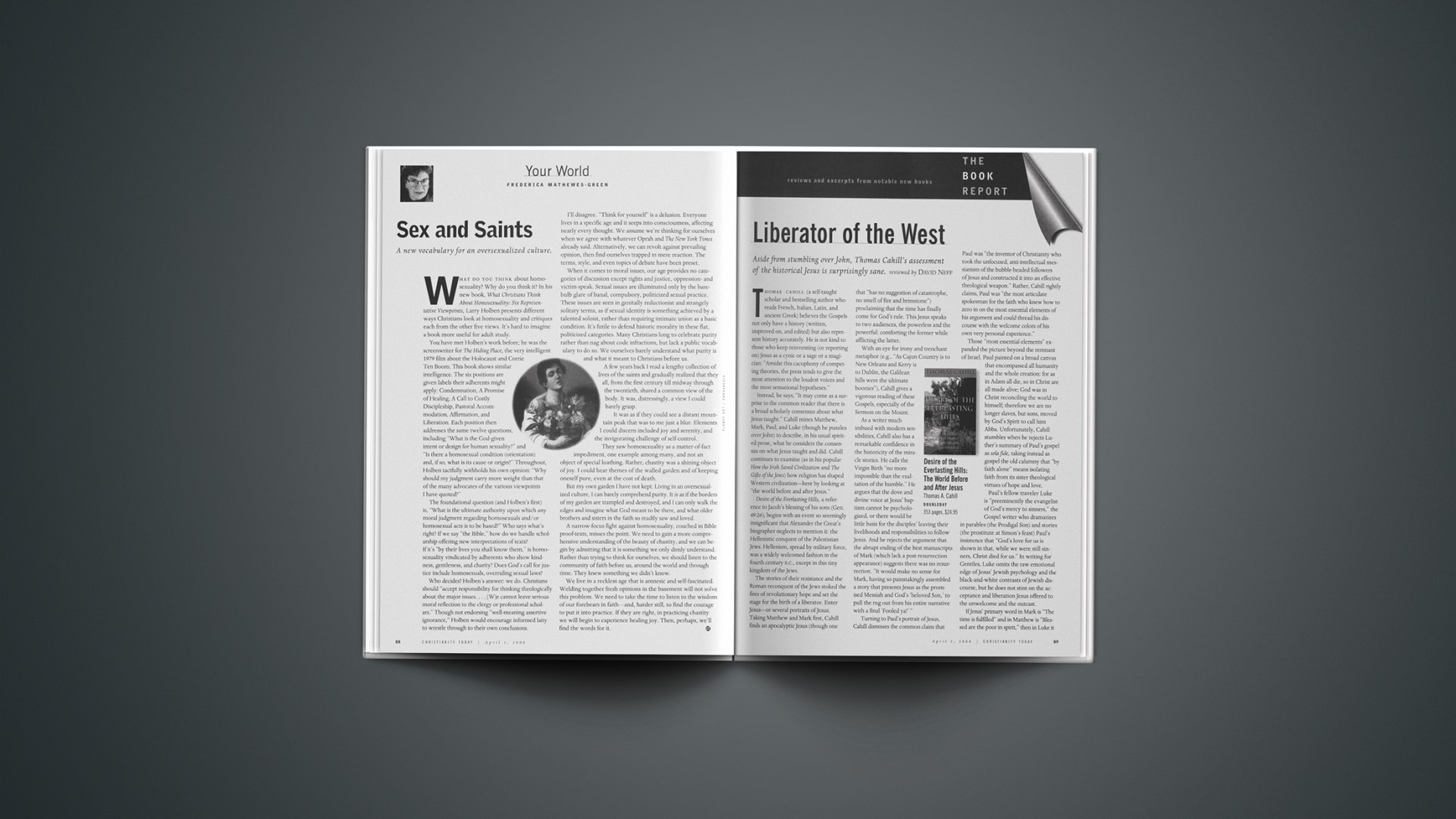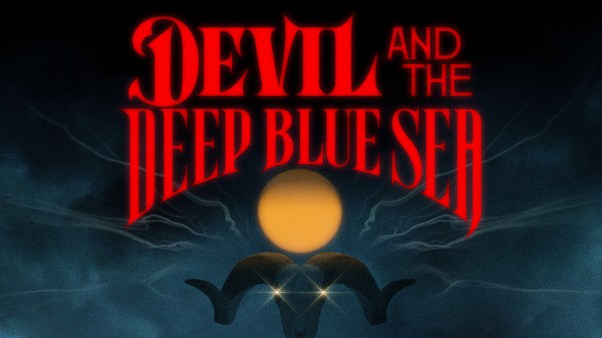Desire of the Everlasting Hills: The World Before and After Jesus
Thomas A. Cahill
DOUBLEDAY, 353 pages, $24.95
Thomas Cahill (a self-taught scholar and bestselling author who reads French, Italian, Latin, and ancient Greek) believes the Gospels not only have a history (written, improved on, and edited) but also represent history accurately. He is not kind to those who keep reinventing (or reporting on) Jesus as a cynic or a sage or a magician: “Amidst this cacophony of competing theories, the press tends to give the most attention to the loudest voices and the most sensational hypotheses.”
Instead, he says, “It may come as a surprise to the common reader that there is a broad scholarly consensus about what Jesus taught.” Cahill mines Matthew, Mark, Paul, and Luke (though he puzzles over John) to describe, in his usual spirited prose, what he considers the consensus on what Jesus taught and did. Cahill continues to examine (as in his popular How the Irish Saved Civilization and The Gifts of the Jews) how religion has shaped Western civilization—here by looking at “the world before and after Jesus.”
Desire of the Everlasting Hills, a reference to Jacob’s blessing of his sons (Gen. 49:26), begins with an event so seemingly insignificant that Alexander the Great’s biographer neglects to mention it: the Hellenistic conquest of the Palestinian Jews. Hellenism, spread by military force, was a widely welcomed fashion in the fourth century B.C., except in this tiny kingdom of the Jews.
The stories of their resistance and the Roman reconquest of the Jews stoked the fires of revolutionary hope and set the stage for the birth of a liberator. Enter Jesus—or several portraits of Jesus. Taking Matthew and Mark first, Cahill finds an apocalyptic Jesus (though one that “has no suggestion of catastrophe, no smell of fire and brimstone”) proclaiming that the time has finally come for God’s rule. This Jesus speaks to two audiences, the powerless and the powerful: comforting the former while afflicting the latter.
With an eye for irony and trenchant metaphor (e.g., “As Cajun Country is to New Orleans and Kerry is to Dublin, the Galilean hills were the ultimate boonies”), Cahill gives a vigorous reading of these Gospels, especially of the Sermon on the Mount.
As a writer much imbued with modern sensibilities, Cahill also has a remarkable confidence in the historicity of the miracle stories. He calls the Virgin Birth “no more impossible than the exaltation of the humble.” He argues that the dove and divine voice at Jesus’ baptism cannot be psychologized, or there would be little basis for the disciples’ leaving their livelihoods and responsibilities to follow Jesus. And he rejects the argument that the abrupt ending of the best manuscripts of Mark (which lack a post-resurrection appearance) suggests there was no resurrection. “It would make no sense for Mark, having so painstakingly assembled a story that presents Jesus as the promised Messiah and God’s ‘beloved Son,’ to pull the rug out from his entire narrative with a final ‘Fooled ya!’ “
Turning to Paul’s portrait of Jesus, Cahill dismisses the common claim that Paul was “the inventor of Christianity who took the unfocused, anti-intellectual messianism of the bubble-headed followers of Jesus and constructed it into an effective theological weapon.” Rather, Cahill rightly claims, Paul was “the most articulate spokesman for the faith who knew how to zero in on the most essential elements of his argument and could thread his discourse with the welcome colors of his own very personal experience.”
Those “most essential elements” expanded the picture beyond the remnant of Israel. Paul painted on a broad canvas that encompassed all humanity and the whole creation: for as in Adam all die, so in Christ are all made alive; God was in Christ reconciling the world to himself; therefore we are no longer slaves, but sons, moved by God’s Spirit to call him Abba. Unfortunately, Cahill stumbles when he rejects Luther’s summary of Paul’s gospel as sola fide, taking instead as gospel the old calumny that “by faith alone” means isolating faith from its sister theological virtues of hope and love.
Paul’s fellow traveler Luke is “preeminently the evangelist of God’s mercy to sinners,” the Gospel writer who dramatizes in parables (the Prodigal Son) and stories (the prostitute at Simon’s feast) Paul’s insistence that “God’s love for us is shown in that, while we were still sinners, Christ died for us.” In writing for Gentiles, Luke omits the raw emotional edge of Jesus’ Jewish psychology and the black-and-white contrasts of Jewish discourse, but he does not stint on the acceptance and liberation Jesus offered to the unwelcome and the outcast.
If Jesus’ primary word in Mark is “The time is fulfilled” and in Matthew is “Blessed are the poor in spirit,” then in Luke it is “The Spirit of the Lord has anointed me to preach good news to the poor.” Indeed, wealth was for Luke one of the major spiritual obstacles, “the preeminent blindfold to spiritual sight,” and in emphasizing this part of Jesus’ teaching, he is more radical than his fellow evangelists.
As Cahill moves into the story of the early church, we glimpse more clearly how this book fits into his series. He recounts the story of Philemon and Onesimus and writes that “Paul’s insistence to Philemon that there are no slaves, only brothers” will flower into the antislavery activities of Patrick, the seventeenth-century Anabaptists, the nineteenth-century abolitionists, and the twentieth-century civil- and human-rights movements.
Likewise, Paul’s advice to widows to remain free of marital entanglements blossoms into the monastic sisterhoods ruled by the powerful likes of Catherine of Siena and Hildegard, and finally into fuller freedom for women this century. Along with caring for the poor and sharing of wealth, these humanizing effects on civilization mark the difference between the world before and the world after Jesus.
Though willing to feel the ethical demands of the synoptic tradition, Cahill shrinks from the hard theological matters of John. He thinks John gives us a Jesus who is “the gravitas-encrusted Christ of the ancient creeds, of tasteless religious art, of German passion plays and Hollywood movies. He is the immobile icon loved by ecclesiasts and theologians.”
Cahill spins out a not uncommon line about a Johannine theology influenced by a culture of “Asiatic pomp and rhetorical exaggeration,” giving us a Jesus whose titles compete with those of Alexander and the Caesars. Furthermore, the Johannine “insistence on there being but one way of thinking” makes John “the favorite evangelist of the uptight and unrelenting.” Cahill is careful to blame those who followed John for turning his “high Christology, poetic and liturgical hyperbole, into rigid dogma.” But Cahill still does not like John.
Cahill, like so many in our time, is fascinated with Jesus. And unlike many, he has confidence in the unified portrait that emerges from the Gospels. Yet he drags his feet on John’s high Christology, as well as on Paul’s doctrine of substitution (while ignoring Paul’s earlier and equally high Christology in Colossians 1 and Philippians 2). The synoptics’ ethical demands, he insists, are the essence of the change Jesus brings, but John’s theological demands are an encrustation. But why should those theological demands bind us any less? Are they not all part of the same whole?
All in all, Cahill’s book is a fresh and energetic look at the “historical Jesus”—who he was in history and what he’s done for history. Ironically, however, Cahill utters a warning that both we and he need to hear: “Christians have been far more successful at rejecting Jesus than any Jew has ever been.”
Related Elsewhere
Desire of the Everlasting Hills is available from Worthybooks and other online retailers.
Cahill’s official site offers information about the author and the “Hinges of History” series. It also has an essay on “how to read the Bible,” message boards, book giveaways, tour information, discussion questions, and other resources.
An excerpt from the book is also available many places online.
The New York Times Book Review says Desire of the Everlasting Hills “remains divertingly instructive and imparts gratifying dimension to the beginnings of what later became known as Christianity. Most important, it makes of Jesus a still-living literary presence.”
An excerpt from Cahill’s How the Irish Saved Civilization appeared in Christian History‘s issue “How the Irish Were Saved.”
Copyright © 2000 Christianity Today. Click for reprint information.










